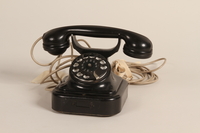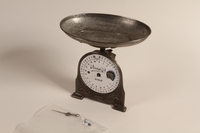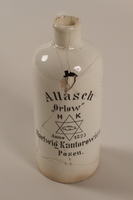Overview
- Brief Narrative
- Billy I self-erecting camera with bellows made by AGFA [Aktien-Gesellschaft für Anilin-Fabrikation] from 1930-1931. This was one of the first AGFA automatic box cameras with rollfilm, and the basis for a long-running series. The film manufacturing company began producing cameras under its own logo from the mid-1920’s, including the first Billy series model. In December 1925, AGFA merged with 5 German companies, including BASF, Bayer, and Hoechst, to form IG Farben, the largest chemical manufacturer in the world. In February 1933, IG Farben contributed 400,000 reichsmarks to the new Nazi government. Initially, the company resisted the antisemitic racial policies such as the Nuremberg Laws of 1935. But by 1937, all Jewish employees, board members, and executives had been removed, and the majority of the remaining board members joined the Nazi Party. IG Farben was an integral part of the war economy, often taking over chemical factories in regions taken over by Germany. They used over 35,000 forced and slave laborers in their factories, including one near Auschwitz III – Monowitz (Buna) concentration camp, and supplied the Zyklon B used in the gas chambers. After the war ended in May 1945, IG Farben was dismantled by the Allies. In 1947, the company’s top officials were tried by the International Military Tribunal in Nuremberg for war crimes and crimes against humanity. Thirteen of the 24 defendants were found guilty of at least one of the five counts.
- Date
-
manufacture:
1930-1931
- Geography
-
manufacture:
Germany
- Credit Line
- United States Holocaust Memorial Museum Collection
- Markings
- front, center, stand, embossed : Agfa
lens, front top, red diamond, embossed, black paint : Agfa
lens, top, black panel, engraved : B 25 50 100
lens, front top left, black panel, engraved : infinity – 5m 5 - 2 m / infinity – 16 feet
lens, front bottom, black panel, engraved : 18 12.5 8.8
back, center, embossed : Agfa
interior, front, bellow bellows, black diamond, embossed : Agfa
interior, back top, engraved : 5x 1304
interior, back top and bottom, painted, red paint : Agfa – Film – B2 - - Contributor
-
Manufacturer:
AGFA (Aktien-Gesellschaft für Anilin-Fabrikation)
Physical Details
- Language
- German
- Classification
-
Audiovisual and Photographic Materials
- Category
-
Cameras
- Object Type
-
Agfa camera (lcsh)
- Physical Description
- Self-erecting rollfilm camera in a rectangular, black painted silver colored metal casing with rounded corners and panels covered with textured black leatherette. Pushing a metal button on the upper left side releases a front panel which pulls a metal lens mount on a telescoping black leather bellows outward on a metal frame. It locks into place and is supported by a hinged, metal stand on the front. The clear glass lens is set into a beveled silver colored ring within a flat, ridged black ring attached to the frame. The ring has 3 sliding setting indicators: 2 arrows and a tab. At the top left are 2 shutter levers and a self-timer mount. At the top right is a pivoting view finder with an interior mirror and 2 clear glass lens: 1 on the front and 1 on top in a cross-shaped frame. The bottom exterior has a continuous silver colored hinge, and across the top is a short, black leather strap. Below it is a metal plate with an engraved arrow and a sliding release to open the casing. On the upper left is a flat twisting film advance key. On the lower left and front are threaded metal tripod mounts. The back has a circular red glass window. The interior front has film advance rods with a black metal spool and the back has a pressure sensitive plate. Part of the lens mount ring is missing.
- Dimensions
- overall: Height: 6.625 inches (16.827 cm) | Width: 3.375 inches (8.573 cm) | Depth: 1.375 inches (3.493 cm)
- Materials
- overall : metal, leather, glass, plastic, paint
Rights & Restrictions
- Conditions on Access
- No restrictions on access
- Conditions on Use
- No restrictions on use
Keywords & Subjects
- Geographic Name
- Germany--Social life and customs.
Administrative Notes
- Legal Status
- Permanent Collection
- Provenance
- The camera was acquired by the United States Holocaust Memorial Museum in 1990.
- Funding Note
- The cataloging of this artifact has been supported by a grant from the Conference on Jewish Material Claims Against Germany.
- Record last modified:
- 2024-03-15 16:20:59
- This page:
- https://collections.ushmm.org/search/catalog/irn4105
Download & Licensing
In-Person Research
- By Appointment
- Request 21 Days in Advance of Visit
- Plan a Research Visit
- Request to See This Object
Contact Us
Also in Early 20th century Germany business equipment collection
The collection consists of an AGFA Billy I automatic camera, a Kantorowicz liqueur bottle, a Reichspost W28 rotary phone, and a spring balance scale as examples of personal and business equipment that would have been in use in Germany in the early 20th century.
Date: approximately 1880-approximately 1938

Deutsche Reichspost W28 model desktop rotary phone
Object
Siemens and Halske W28 model rotary dial telephone commissioned by the Deutsche Reichspost [German Post Office) as its standard issue model from 1928. In the mid-1930s, the Reichspost commissioned a new model seeking a more economical and reliable device. They passed on the model produced in 1936. The W38 model was adopted but not introduced on a large scale until 1940. Some parts, such as the bell, were made of different materials due to war economies. The W38 was sturdier and introduced a dialing pause to make connections more consistent.

10 kilo economic spring balance scale with a weighing pan
Object
Ten kilo (22 pound) spring balance scale with weighing pan likely produced in Germany around the turn of the 20th century. Scales such as this would be used at small farms or shops to weigh vegetables or other solid materials.

Hartwig Kantorowicz ceramic liqueur bottle
Object
Ceramic liqueur bottle for Orlow brand cumin cream produced by Hartwig Kantorowicz distillery and liqueur factory in Posen, Germany, between 1880 and 1920. In 1917, following World War I, the town, now called Poznan, became part of the newly reformed Poland. The distillery was founded in 1823 by a Jewish man, Hartwig Kantorowicz, and quickly gained a reputation for creating high quality products. It was a prosperous family business and opened several branches in Hamburg and Berlin. The majority of their products were liqueurs sold in glass bottles produced by Silesian, Saxon, and Czech glass factories. The distillery also sold patent medicines, like tonics and bitters, in bottles they manufactured for their own products as well as several other companies. These products often included high percentages of alcohol and were heavily spiced with strong, supposedly medicinal herbs.



